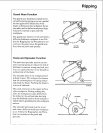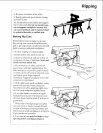
Cutting Aides
Auxiliary Fence for Edging
You must use an auxiliary fence for
edging because you cannot completely lo-
cate the cutting tool behind a rip fence.
Also, edging requires the use of a molding
head guard (see Accessories).
To make an auxiliary fence for edging, use
3/4"knot-free lumber. Cut two pieces to
dimensions shown (inches). To form
fence, glue both pieces at right angles to a
piece of lumber _/4"x 1". Reinforce with
nails.
Install the fence in the front position.
Reverse order of rear and spacer tables,
because to use molding head or drum
sander with arbor vertical, you may have
to make a 3" x 31/F opening in rear table
for arbor clearance in order to get cutting
tool closer to table. (Spacer table is too
narrow for such an opening.)
Note: Initial edge cut will round angled
edges offence.
Note: I47zen using drum sander, vacuum
motor @en to prevent sawdust!powder
build-up, because powder interferes with
motor ventilation and can clog, starter
switch.
Featherboard
Use a featherboard on the infeed side
during ripping to help keep the workpiece
against the fence.
To make a featherboard, use knot-free _/4"
lumber 5 v_2"wide. Miter crosscut lumber
at a 30 ° angle to 24". Rip to make 5" long
cuts about 1/4"apart.
17
16
Spacer Table
Rear Table
3¸¸¸4
Rear - 1 _-_ 3 3-1;2
Table- 4 _ _ _
U
_19_
These Edges Musl
Be Parallel
\
_'_ 5-1,8 _
3,4 Plywood
5 "12 /
1-1/4 x
1-1/4
2-1 ,'2
3/8
!
l
3,'8 Plywood
3/8
5-1/2
5
4-1,,2
7O


















